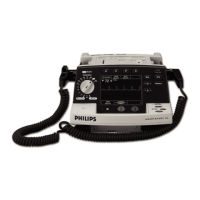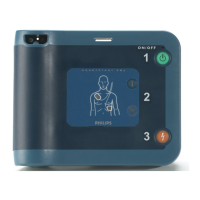Automated Tests 3: Troubleshooting
31
Automated Tests
The HeartStart XL+ performs many maintenance activities independently, including three tests that run
automatically at regularly scheduled intervals while the device is off to assess operational performance and
alert you if a problem exists. Results of tests associated with critical functionality of the device are
reported through the RFU indicator and the Automated Test Summary report. Results are also reported
through Technical Alarm messages on the display when the HeartStart XL+ is turned on. Tab le 6
provides a brief explanation of the tests and lists the frequency with which each test is performed.
NOTE: Automated tests do not test the therapy cables, paddles, buttons, audio, or the display.
Automated Test Summary
An Automated Test Summary (ATS), showing the results of recent tests, may be viewed or printed as
evidence that the HeartStart XL+ is tested regularly.
To v ie w t he AT S:
1 Tu r n th e Th er a py Kn o b t o Monitor.
2 Press the Menu Select button.
3 Using the Navigation buttons, select Other and press the Menu Select button.
4 Select Operational Check
and press the Menu Select button.
5 Using the Navigation buttons, select
Auto Test Summary and press the Menu Select button.
The message appears: Leaving clinical mode.
6 Navigate to Yes and press the Menu Select button to confirm the Exit Clinical Mode?
request.
7 Press the Print soft key to print the report.
Table 6 Automatic Self-Tests
Test Type/Frequency Components and Parameters Tested
Hourly (short) • power supplies,
• charge level of the battery,
• internal communication across all critical modules and
components
• device’s internal temperature.
Daily after midnight
(medium)
Performs an Hourly Test, plus:
• internal clock battery
• defibrillation (including low-energy internal discharges)
•pacing
•ECG
•SpO
2
, NBP, and EtCO
2
(as installed)
•USB
•Printer
• 3- or 5-lead ECG cable (if connected).
Sunday early mornings
(long)
Performs a Daily Test, plus a 150-J internal discharge to exercise
the entire defibrillation circuitry.

